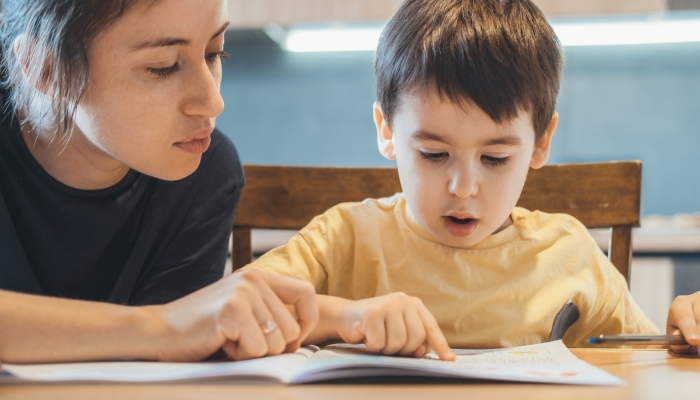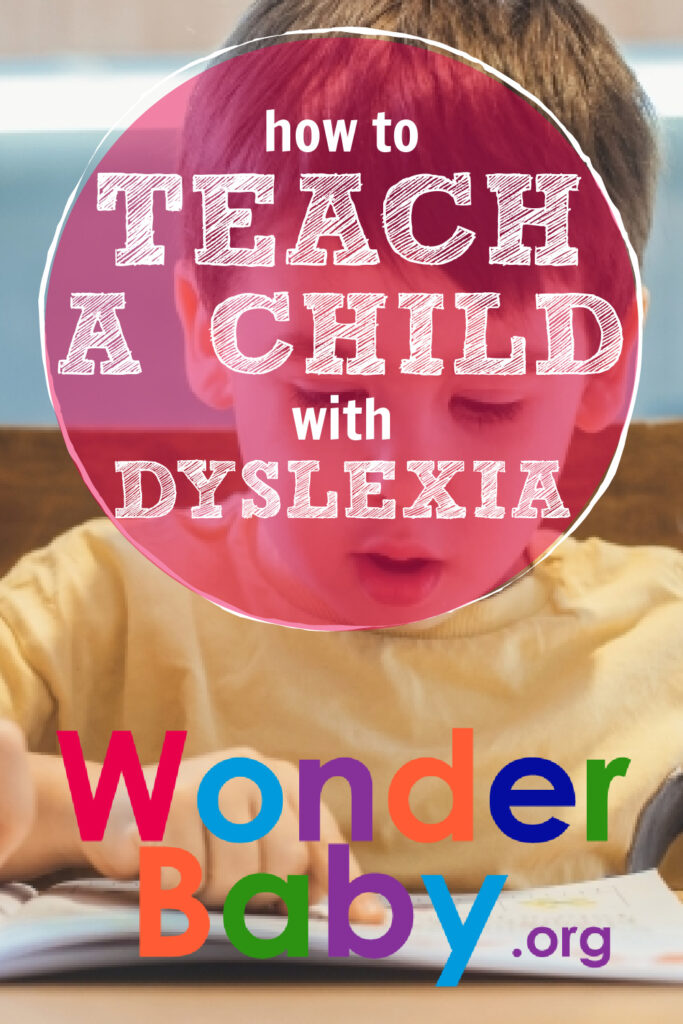How to Teach a Child With Dyslexia

- Dyslexia is a neurological processing disorder that affects reading and writing specifically.
- Dyslexia does not impair or impede kids in other areas of intelligence and it doesn’t mean that they aren’t smart.
- Diagnosis by an educational psychologist and early intervention can teach kids with dyslexia to cope with their reading challenges.
- Dyslexic kids need to know that their processing difficulties do not have to be a barrier to their success in school or later in life.
- With enough support, students with dyslexia can engage with reading and get the most out of their education.
My sons are aged 9 and 11. They talk a lot and they have big vocabularies. They are creative with big imaginations and they make up great stories. My younger son is great with puns. My older son is very quick at non-verbal puzzles and can talk to you all day about history. They are very bright boys. They also have dyslexia.
Reading is challenging for them. They have a hard time with organization, taking tests, handwriting, and spelling. They struggle with math word problems. They confuse instructions and it takes them a long, long time to do written assignments for homework.
Yet two to three years after diagnosis, with support from their teachers, some time with a private tutor, reading aloud to them every day, and teaching them strategies for how to handle their learning challenges, they are both enjoying school and even excelling in some academic subjects.
Most importantly, they both know that dyslexia just means that they learn differently. It doesn’t mean that they aren’t smart. It also doesn’t have to limit what they want to do with their lives.
With support, patience, early diagnosis and intervention, you can teach a child with dyslexia not only to cope with its challenges but also to build their confidence with literacy. Most importantly, you can teach them that their dyslexia does not have to be a barrier to their future success.
What Is Dyslexia?
According to the National Institutes of Neurological Disorders, dyslexia is a brain-based learning disability that specifically affects the brain’s activities around reading. There is a neurological difficulty with processing written words visually and phonetically in the brain of a dyslexic child.
The reading skills of kids with dyslexia are often lower than expected for their age despite having typical or even above-average intelligence. The reading ability of a dyslexic child usually does not match their intellectual abilities in other areas.
Dyslexia has a strong genetic component, and it’s not uncommon to find that more than one member of a family is affected. Often, adults who were not diagnosed in childhood discover that their lifelong struggles with reading are dyslexia once their children are identified as having this learning disability.
The American Psychological Association notes that dyslexia is not a result of a lack of motivation, sensory impairment, poor instruction, or emotional problems. It is an information processing disorder specific to reading and language, and it does not indicate low intelligence or the presence of other intellectual disabilities.
Children with dyslexia may see words on a page differently than a neurotypical child. Words or letters may appear inverted or reversed, they might move, and some fonts may be harder for dyslexic kids to read than others.
However, it is important to distinguish dyslexia from low vision or visual impairment. Dyslexia is a neurological condition that affects the processing of visual information by the brain. It is not a condition that affects a person’s eyesight.
There is no cure for dyslexia. With early intervention, assessment, and the proper support, dyslexic children can learn to read and write with confidence and they can find success in their academic and work lives.

Signs of Dyslexia
Signs of dyslexia most often become apparent when a child enters school and is beginning to learn to read. However, dyslexia is not always picked up in young kids and may not be diagnosed until adolescence or even adulthood.
Signs of dyslexia will emerge in different ways for different age groups and at different periods of life.
| Young Children | School Age Children | Teens and Adults |
|
|
|
Teachers are often the first people to notice the learning differences of students with dyslexia. When teachers and parents work together closely, they can create a supportive learning environment that is consistent at home and school.
How Is Dyslexia Diagnosed?
If you or your child’s teacher or another professional who works with them has noticed that your child has signs of dyslexia, an assessment by a certified educational psychologist is a good idea. This assessment is the basis for a diagnosis.
To conduct the assessment the psychologist will:
- Conduct interviews or questionnaires with teachers, parents, and caregivers
- Collect information from school like report cards
- Gather a family history from parents about dyslexia present in the family and any speech or developmental delays in early childhood
- Conduct a series of tests with your child that cover the following:
- Decoding
- Vocabulary
- Oral language skills
- Reading fluency
- Reading comprehension
- Spelling
- Word recognition
Receiving a diagnosis as early as possible is important because early intervention is key to helping children with dyslexia. Having the right support in the learning environment from a young age is important for dyslexic learners.
Adjusting teaching methods in the classroom and working with a tutor can help kids with dyslexia to read and learn at their own pace. Working with dyslexic kids as early as possible allows them to develop the self-help skills they will need to cope with reading for the rest of their lives.
Challenges Children With Dyslexia Face
Children with dyslexia, particularly if it goes undiagnosed for many years, can face many different challenges, at school, at home and socially. The key is to help them to find strategies to deal with the things they find challenging so that these difficulties do not start to harm their self-esteem.
Challenges at School
Dyslexic students may have challenges at school that are not just about reading. People with dyslexia often have trouble with:
- Organizational and executive functioning skills
- Following sequential instructions
- Telling left from right
- Following travel instructions
- Remembering important assignments or due dates
- Memorization tasks
- Telling time
- Expressing themselves
Social and Emotional Challenges
As a result of their difficulty with processing words and expressing themselves, children with dyslexia can also face some social and emotional challenges:
- Difficulty joining in conversations because they have trouble finding the words they want to say or can’t express themselves quickly enough
- Trouble with memory and detail can lead to misunderstandings about what friends are saying or what is happening in social situations
- Low self-esteem that results from thinking they are not as smart or able as other kids
- If they are not reading as much as other kids, they can feel out of the loop about popular books that other kids love like Harry Potter
- Getting discouraged about catching up with their peers and feeling singled out, especially if they are receiving extra tutoring or being pulled out of class for reading help
Facing Dyslexia Challenges
Although it is important to be honest about the difficulties of having dyslexia, it is also important to highlight to your child the many positive attributes of people who think differently like they do.
People with dyslexia are also known to be:
- Excellent problem-solvers
- Creative thinkers with big imaginations
- Great at spatial reasoning
- Abstract thinkers
- People who think outside the box
- People with excellent spoken verbal ability who are great at conversation and learning things aurally
Many famous actors, inventors, artists, athletes, and entrepreneurs are dyslexic. It is important to let dyslexic children know that while dyslexia does present them with some challenges, it also gives them strengths that will help them succeed in whatever they want to do.

Strategies for Teaching a Child With Dyslexia
There are different strategies and approaches that teachers and parents can take to teaching children with dyslexia.
Isolate and Manipulate Sounds in Words
According to Andreah Evans, a certified dyslexia therapist, the main issue with dyslexia is, “the inability to get to the individual speech sounds (phonemes) of language. Children with dyslexia have phonemes (speech sounds) that are not well established [which] makes it more difficult to tie those ill-established sounds to letters which affect spoken language, reading, and writing.”
The way to assist a child who has trouble with phonemic awareness, according to Evans, is to practice, “blending sounds, segmenting sounds, as well as adding and deleting sounds.” For example, to practice blending, ask your child, “What word do you get when you put the sounds (d)(e)(s)(k) together?” This helps children practice decoding.
Evans says that “segmenting” words with children is a way of, “facilitating a spelling skill. For instance, parents can ask a child to unblend the word ‘pet’. Segmenting the word into individual sounds is a skill set we use when spelling.” Unblending means breaking the word into its individual letters p-e-t and sounding them out individually. Then blend them by sounding them out together.
Reading Programs
Some parents or schools might choose a reading program that helps teach children reading basics through a dyslexia-friendly approach. Look for programs that include the following:
- Multi-sensory approaches to learning
- Repetition of concepts and skills
- Daily practice
- Small group or individual instruction
- Drilling sight words
- Help with comprehension strategies
Accommodations for Dyslexic Students
There are simple ways to support kids with dyslexia that recognize their ability to learn but also acknowledge that they take in information differently. Parents might consider doing the following at home or asking for these accommodations at school:
- Listening to audiobooks or reading a physical book in tandem with listening
- Using a tablet or ebook reader to access digital books that can change the print to dyslexia-friendly fonts for easier reading
- Allowing students to type assignments on tablets or computers rather than writing them by hand
- Exempting students from reading aloud in class
- Allowing extra time on tests
- Allowing oral rather than written answers where possible
When some of the pressure of the mechanics of reading and writing are removed, dyslexic students have more opportunities to demonstrate their knowledge and their abilities.

The information WonderBaby provides is not intended to be, and does not constitute, medical or other health advice or diagnosis and should not be used as such. Always consult with a qualified medical professional about your specific circumstances.
Related Posts

Eye Conditions and Syndromes, Visual Impairment
Neuralink Announces Plans to Restore Sight to the Blind with Brain Chip
Elon Musk’s company Neuralink has announced plans to begin human trials of its new “Blindsight” brain chip by the end of 2025.

Special Needs
5 Spring Cleaning Tips for Families of Children with Disabilities
Spring cleaning is an opportunity to create a more accessible, organized, and supportive space for your child with disabilities. Declutter, deep clean, and refresh!

Visual Impairment
The Gift of Understanding: How a Young Child Helps His Blind Father Navigate Life
When a parent is blind, it’s natural for people to wonder how their sighted child will adapt. Will they struggle to understand their parent’s needs? Will they feel burdened by...